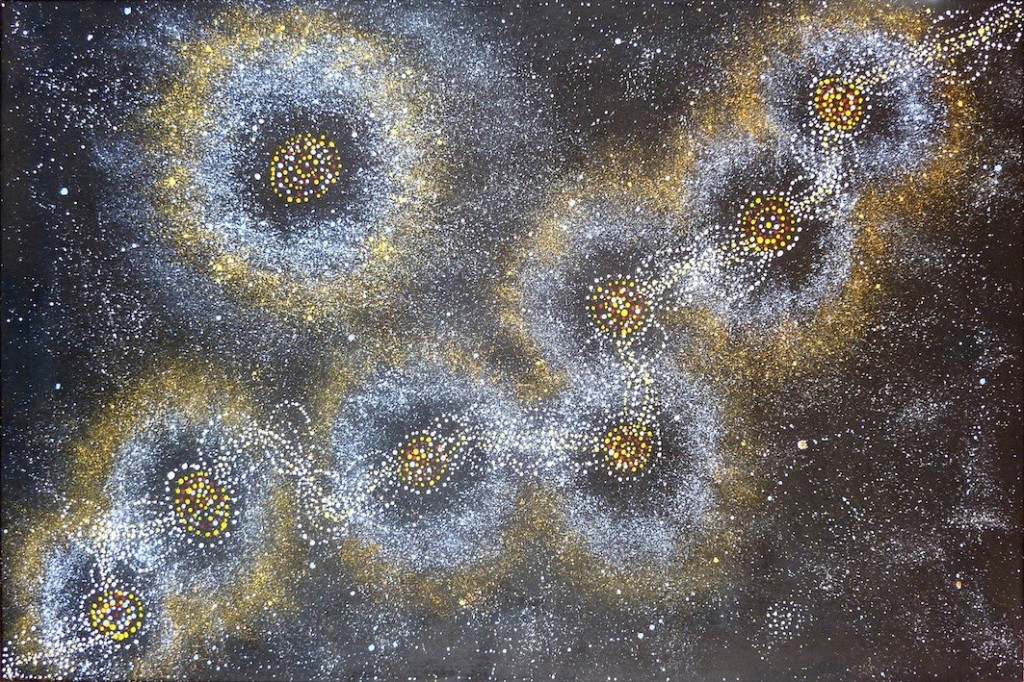
Alma – Star or Seven Sisters Dreaming, 2011 – 122x76cm.
“Ceci n’est pas un ciel étoilé”
If I borrow the famous quotation of René Magrite, it is to pay homage to Michel Foucault’s text that subtly reveals the underlying tension existing between a painting and its text. At the occasion of the International Woman day, I would like to introduce a similar issue on the last series of painting done by Alma Nungarrayi Granites. In a sombre dark night sky, seven asters shine with a blue electric glow on the top of the paintings, another spot, alone, located in the dusty brownish at the bottom, also shines from this same bluish light.
The artist, Alma, belongs to the second generation of artists from Yuendumu, who are working full-time and her main subject refers to the Jukurrpa Yanjirlpirri or Napaljarri-Warnu, often translated as the Seven Sisters dreaming. According to the customary Aboriginal law, her right to depict this tale does not cover the whole myth but just an extract of it. The plot relates how seven girls flee a man of the same classificatory family (skin-name). To escape their offender, they migrate in the sky and become the Pleiades stars. Alma has inherited this jukurrpa from her parents, and even if she shares it with others artists such as Wendy Nungurrayi Brown, her interpretation and this subject is intrinsically linked with her identity.
So why such an image deeply rooted in the Warlpiri culture might specially be interested to this day of all the women? Because these paintings are addressed to a wider audience. The interpretation of Alma does not lie to the traditional sign and vocabulary of Warlipiri forms describes by Nancy Munn . Her paintings can be categorised as a naturalistic representation of a night sky. Indeed, in one of her interview, Alma explained that she appreciates to spend the night to contemplate stars before working on her paintings. Moreover, her main subject, the Pleiades, is one of the few constellations that can be seen both from the Northern and the Southern Hemisphere. Alma opens the content of her paintings with a treatment can be clearly understood by both cultures.
The story deals with women harassed by men. However the painting’s subject is centred on the ascension of the women to the rank of stars. Their metamorphosis sublimes their deed to deliberately refuse the status of a permanent victim and act in consequence. The violence against women is a crucial issue in the indigenous world but not only, every day, there is news that evokes similar cases. In the case of domestic violence, women need much more courage to leave their home and their family in order to protect themself. These paintings can be read as a monument to these mythological heroines.
To conclude, in these paintings, there is neither stars nor women. It remains only acrylic on a canvas however the symbols, the drama evoked and the beauty of the stars should inspire us in this International Woman Day.
Georges Bureau
References:
1) FOUCAULT, Michel. “This is not a Pipe“. Berkeley, University of California Press, 1983.
2) MUNN, Nancy. “Walbiri Iconography: Graphic Representation and Cultural Symbolism in a Central Australian Society“. Ithaca: Cornell University Press, 1973
3) Interview by Aboriginal Art Directory, published the 13.09.10.
About the Author:
Georges Bureau, ex team member at IDAIA and Curator of exhibition Gestuelles – the art of transmission by Aboriginal Desert women at Alliance Francaise de Canberra in 2012.
Artwork © The Artist